Ventilation
Why is ventilation so important?
Effective ventilation is important for the following reasons:
-
Removal of excess carbon dioxide (maintaining 425-1000 ppm is considered good and acceptable, respectively)
-
Control of humidity- between 30-70% RH is considered optimal for human comfort and health
-
Removal of excess heat from equipment, lighting and people
-
Prevention of surface moisture condensation (from high humidity levels)
-
Dilution of high concentrations of airborne bacteria and viruses.
-
Dilution of internal contaminants such as dust, gases (including VOCs)
-
Removal of unpleasant odours and the provision of freshness
Increasing ventilation rates has a significant impact on reducing the risk of any airborne disease transmission. Studies have shown in-classroom transmission can be reduced by over 80% with appropriate ventilation. Moreover, in addition to the well-documented effect on long-range transmission there is emerging evidence that increased room ventilation rates can also reduce short-range airborne transmission.
Studies have shown that classroom CO2 monitoring and teacher education are vital to ensure that teachers understand how and when to ventilate appropriately, which is why we have prepared the following information for you.
How do you ventilate properly?
Natural ventilation remains the most widely used ventilation method in Austrian school buildings. A simple and easily implemented means of improving indoor air quality and removing respiratory aerosols and airborne viruses from indoor spaces can be provided by the use of openable windows (i.e. natural ventilation) when correctly implemented.
We recommend different window-opening strategies on warm and cold days:
A − On warm days
-
Always check the CO2 value and make sure it is below 1000 ppm.
-
If the CO2 value exceeds the threshold, please open the windows fully to bring in more air. If your classroom has windows only on one-side, make sure the windows can stay fully-open to bring in the maximum volume of air.
-
If you have windows that open on both sides of the room, you can open them fully as well if required. You will notice that due to temperature difference, it becomes much harder to ventilate properly in summer, which is why it is so important that you open the windows to the maximum extent, if at all possible.
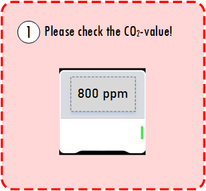
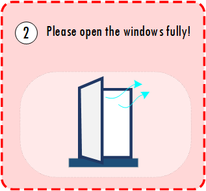
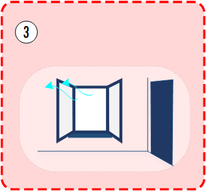
B − On cold days
-
Always check the CO2 value and make sure it is below the 1000 ppm value.
-
On cold days, the indoor temperature will drop significantly if you open the windows fully, so we recommend leaving a few widows continuously tilted to maintain a constant supply of fresh air.
-
We recommend tilting the windows continuously and adjust the number of open windows to maintain the target CO2 concentration. If that is not possible then we advise to purge ventilating every 20 minutes for 3-5 minutes. Localised cold draughts can often be addressed by adding a baffle (or plastic cover) to the side of the window frame to redirect the cold air downwards to the floor.
Wherever possible ventilation using continuously tilted windows is preferable to purge ventilation. Purge ventilation is a manually controlled process, whereby rooms are ventilated at a relatively high rate to rapidly dilute pollutants and refresh the stale indoor air. This can be achieved by opening the windows fully and should take place in classrooms at a 20-min interval (or less) for about 3-5 min' duration (i.e. longer when it is warmer). Purge ventilation should also take place during breaks between classes (e.g. using the 20-5-20 minute rule). Ventilating only during the breaks is insufficient to maintain the hygienic targets (CO2 concentration) during classes.
You will notice that it is much more difficult and time consuming to strictly follow the process of purge ventilation which is why it might be easier to keep the windows tilted. Note that many facility managers will tell you that the energy consumption due to tilted windows is significantly higher but this is factually incorrect.
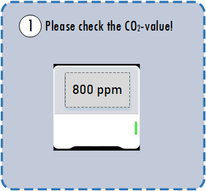
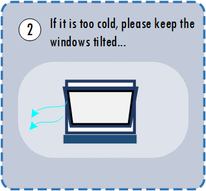
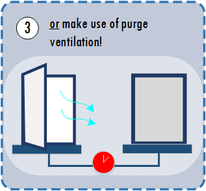
C − If you have a centralised mechanical ventilation system, air conditioning or air cleaners
-
As always please keep an eye on your CO2 sensor (1). Just because you have a mechanical ventilation system (or other automated means of ventilation) installed, does not necessarily guarantee sufficient indoor air quality.
-
If you have a centralised (or decentralised) mechanical ventilation system installed in your school, it might not be necessary to open your windows. The ventilation rate should automatically adjust to the indoor requirements (e.g. the number of people in the room). If you notice that the CO2 values are quite high and often exceed the 1000 ppm threshold, please inform your facility manager so that he or she can check the system has the right settings installed (ideally the system should be set to 800 ppm or lower).
-
It is important to distinguish mechanical ventilation from an air-condition unit. The latter might be installed simply to cool or heat the air in your room but in the process re-circulate internal room air, instead of supplying fresh air. In such situations the CO2 will rise constantly, and you must continue to open the windows as explained in the two scenarios above.
-
Mobile air purifiers can help reduce aerosol particle concentrations and thus reduce indirect infection hazards. However, mobile air purifiers have the fundamental disadvantage that they do not lead to a renewal of the room air. They can, therefore, only serve as an additional supportive measure to reduce for example the airborne risk of infection (or to remove particulate pollutants) but they cannot replace the need for ventilation. Mobile air purifiers are particularly useful at times when infection risks are high (e.g. during seasonal flu outbreaks or Covid19 waves) especially during very cold or hot weather when ventilation via open windows is difficult.
To work effectively, air purifiers must be appropriately sized, sufficiently quiet during operation (≤35 dB(A)) properly set up, correctly positioned, and operated. It is also important to replace or clean the filters at the manufacturer’s recommended service interval.
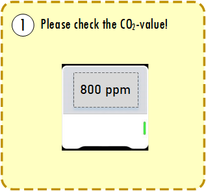
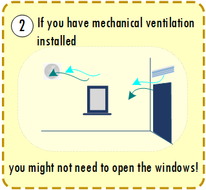
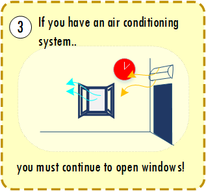
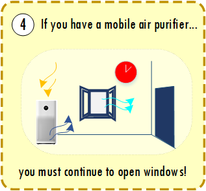
Our 4-step guide includes practical measures to monitor and improve ventilation
A collective approach
To ensure the importance of ventilation is understood and effective ventilation achieved in the classroom, you should:
-
Meet with members of staff (including the facility manager and school director) to discuss ventilation in the classroom and other occupied rooms.
-
Identify any concerns and, where possible, find solutions
-
Raise any issues or concerns collectively with your teacher or the school director.
Step 1 - Gathering evidence of poor ventilation
You can help draw attention to indicators of poor ventilation:
-
Do any areas feel stuffy or unpleasant?
-
Are there areas without natural ventilation, for example rooms without openable windows (or where the windows are permanently locked or secured)?
-
Do ventilation grilles, vents or airbricks appear dirty or blocked?
-
Are the walls or floor damp to touch or speckled with mold?
Step 2 – Monitoring carbon dioxide levels
The level of CO2 acts as a proxy for the relative microbe load in a room as people exhale airborne viruses when they breath out. Use a CO2 sensor to check your classroom or workplace. Ensure that ventilation is sufficient to keep CO2 levels below 1000 ppm and ideally below 800 ppm if possible. Indoor air at values between 600 to 800 ppm carbon dioxide indicates a relatively well-ventilated room.
Step 3 – Practical steps to ensure good ventilation
Examples of possible improvements to ventilation:
-
Airbricks should not be obstructed.
-
Windows should be able to be safely opened and latched in place
-
Ventilation grilles and vents need to be kept clean, so that the air supply is not obstructed.
-
Windows should where possible be kept at least slightly open when rooms are occupied (i..e tilted) (although this can be noise, security/ thermal comfort and fire restrictions dependent).
-
To achieve a balance between ventilation and thermal comfort, uniform and dress codes should be relaxed in colder weather to allow staff and students to dress more warmly but, in addition, schools and colleges should, where necessary, have the heating turned up higher and for longer, starting earlier in the morning, to maintain a comfortable temperature throughout the working day.
-
Draughts are a common complaint in cooler weather but can often be reduced by restricting the degree of window opening or by adding a baffle. A simple baffle can be created by using a curtain or blind over the inside of the window, or by taping a plastic membrane or foil between the side of the window frame and the open casement, to direct cold air downwards onto the floor.
Step 4 – What if these measures are put in place but ventilation is still poor?
Air cleaning and filtration units are an effective means of reducing airborne transmission of pathogenic aerosols where it is not possible to maintain adequate ventilation. These units are not a ‘substitute’ for ventilation, however they can play an important role where ventilation is otherwise insufficient. By filtering and trapping tiny particles of virus, pollution or pollen, they improve the air quality in each space.
